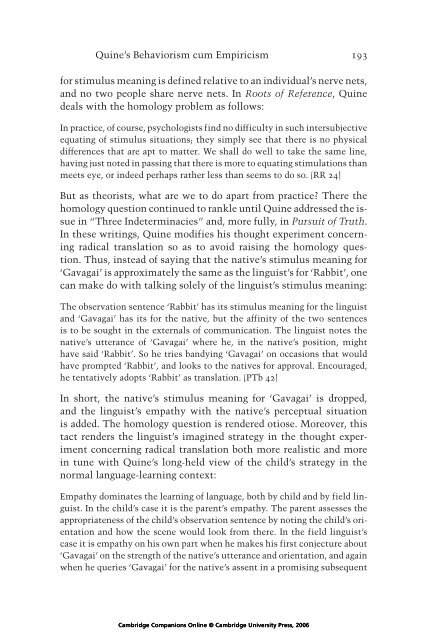Willard Van Orman Quine
Willard Van Orman Quine
Willard Van Orman Quine
Create successful ePaper yourself
Turn your PDF publications into a flip-book with our unique Google optimized e-Paper software.
<strong>Quine</strong>’s Behaviorism cum Empiricism 193<br />
for stimulus meaning is defined relative to an individual’s nerve nets,<br />
and no two people share nerve nets. In Roots of Reference, <strong>Quine</strong><br />
deals with the homology problem as follows:<br />
In practice, of course, psychologists find no difficulty in such intersubjective<br />
equating of stimulus situations; they simply see that there is no physical<br />
differences that are apt to matter. We shall do well to take the same line,<br />
having just noted in passing that there is more to equating stimulations than<br />
meets eye, or indeed perhaps rather less than seems to do so. (RR 24)<br />
But as theorists, what are we to do apart from practice? There the<br />
homology question continued to rankle until <strong>Quine</strong> addressed the issue<br />
in “Three Indeterminacies” and, more fully, in Pursuit of Truth.<br />
In these writings, <strong>Quine</strong> modifies his thought experiment concerning<br />
radical translation so as to avoid raising the homology question.<br />
Thus, instead of saying that the native’s stimulus meaning for<br />
‘Gavagai’ is approximately the same as the linguist’s for ‘Rabbit’, one<br />
can make do with talking solely of the linguist’s stimulus meaning:<br />
The observation sentence ‘Rabbit’ has its stimulus meaning for the linguist<br />
and ‘Gavagai’ has its for the native, but the affinity of the two sentences<br />
is to be sought in the externals of communication. The linguist notes the<br />
native’s utterance of ‘Gavagai’ where he, in the native’s position, might<br />
have said ‘Rabbit’. So he tries bandying ‘Gavagai’ on occasions that would<br />
have prompted ‘Rabbit’, and looks to the natives for approval. Encouraged,<br />
he tentatively adopts ‘Rabbit’ as translation. (PTb 42)<br />
In short, the native’s stimulus meaning for ‘Gavagai’ is dropped,<br />
and the linguist’s empathy with the native’s perceptual situation<br />
is added. The homology question is rendered otiose. Moreover, this<br />
tact renders the linguist’s imagined strategy in the thought experiment<br />
concerning radical translation both more realistic and more<br />
in tune with <strong>Quine</strong>’s long-held view of the child’s strategy in the<br />
normal language-learning context:<br />
Empathy dominates the learning of language, both by child and by field linguist.<br />
In the child’s case it is the parent’s empathy. The parent assesses the<br />
appropriateness of the child’s observation sentence by noting the child’s orientation<br />
and how the scene would look from there. In the field linguist’s<br />
case it is empathy on his own part when he makes his first conjecture about<br />
‘Gavagai’ on the strength of the native’s utterance and orientation, and again<br />
when he queries ‘Gavagai’ for the native’s assent in a promising subsequent<br />
Cambridge Companions Online © Cambridge University Press, 2006
















